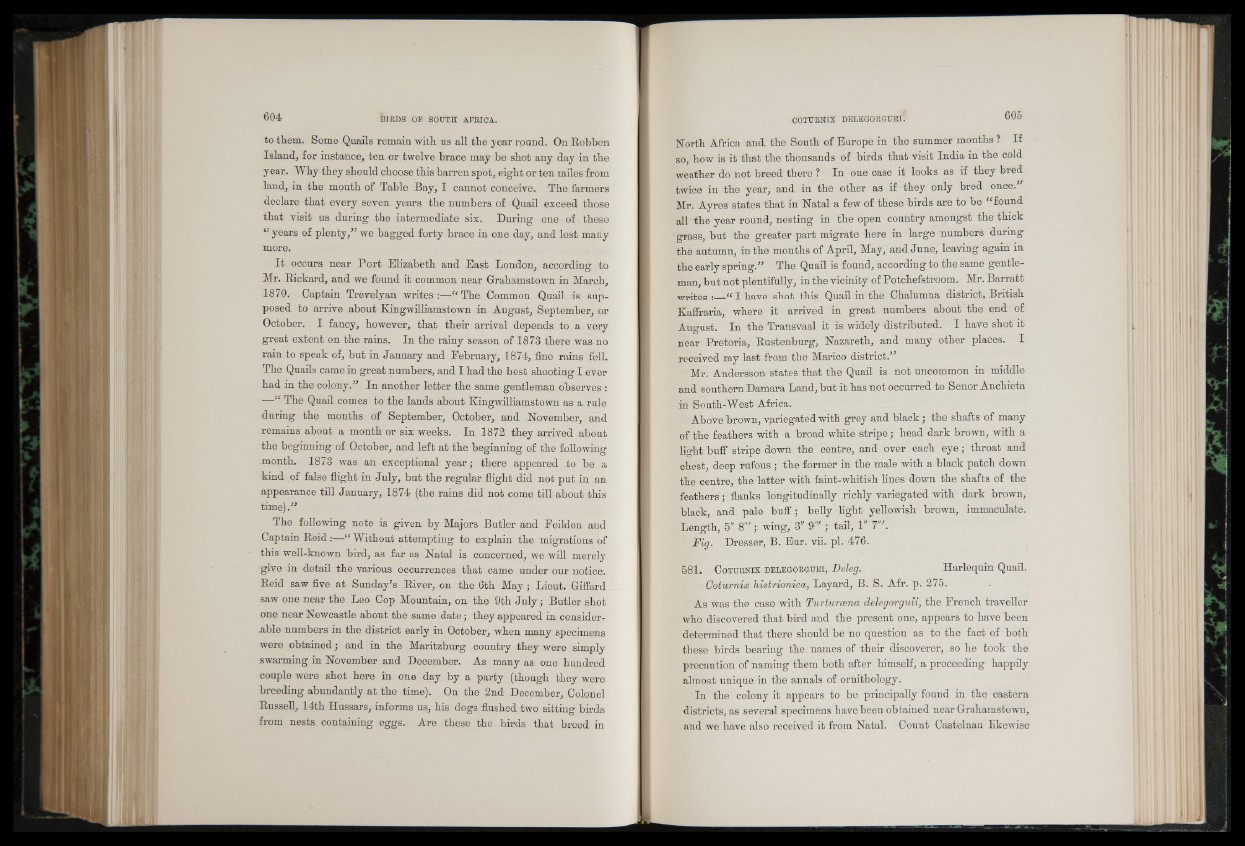
to them. Some Quails remain with us all the year round. On Robben
Island, for instance, ten or twelve brace may be shot any day in the
year. Why they should choose this barren spot, eight or ten miles from
land, in the mouth of Table Bay, I cannot conceive. The farmers
declare that every seven years the numbers of Quail exceed those
that visit us during the intermediate six. During one of these
“ years of plenty,” we bagged forty brace in one day, and lost many
more.
It occurs near Port Elizabeth and East London, according to
Mr. Rickard, and we found it common near Grahamstown in March,
1870. Captain Trevelyan writes:—“ The Common Quail is supposed
to arrive about Kingwilliamstown in August, September, or
October. I fancy, however, that their arrival depends to a very
great extent on the rains. In the rainy season of 1873 there was no
rain to speak of, but in January and February, 1874, fine rains fell.
The Quails came in great numbers, and I had the best shooting I ever
had in the colony.” In another letter the same gentleman observes :
—“ The Quail comes to the lands about Kingwilliamstown as a rule
during the months of September, October, and November, and
remains about a month or six weeks. In 1872 they arrived about
the beginning of October, and left at the beginning of the following
month. 1873 was an exceptional year; there appeared to be a
kind of false flight in July, but the regular flight did not put in an
appearance till January, 1874 (the rains did not come till about this
time).”
The following note is given by Majors Butler and Feilden and
Captain Reid :—“ Without attempting to explain the migrations of
this well-known bird, as far as Natal is concerned, we will merely
give in detail the various occurrences that came under our notice.
Reid saw five at Sunday’s River, on the 6th May; Lieut. Giffard
saw one near the Leo Cop Mountain, on the 9th July; Butler shot
one near Newcastle about the same date ; they appeared in considerable
numbers in the district early in October, when many specimens
were obtained ; and in the Maritzburg country they were simply
swarming in November and December. As many as one hundred
couple were shot here in one day by a party (though they were
breeding abundantly at the time). On the 2nd December, Colonel
Russell, 14th Hussars, informs us, his dogs flushed two sitting birds
from nests containing eggs. Are these the birds that breed in
North Africa and. the South of Europe in the summer months ? If
so, how is it that the thousands of birds that visit India in the cold
weather do not breed there ? In one case it looks as if they bred
twice in the year, and in the other as if they only bred once.
Mr. Ayres states that in Natal a few of these birds are to be “ found
all the year round, nesting in the open country amongst the thick
grass, but the greater part migrate here in large numbers during
the autumn, in the months of April, May, and June, leaving again in
the early spring.” The Quail is found, according to the same gentleman,
but not plentifully, in the vicinity of Potchefstroom. Mr. Barratt
writes :—“ I have shot this Quail in the Chalumna district, British
Kaffraria, where it arrived in great numbers about the end of
August. In the Transvaal it is widely distributed. I have shot it
near Pretoria, Rustenburg, Nazareth, and many other places. I
received my last from the Marico district.”
Mr. Andersson states that the Quail is not uncommon in middle
and southern Damara Land, but it has not occurred to Senor Anchieta
in South-West Africa.
Above brown, variegated with grey and black; the shafts of many
of the feathers with a broad white stripe; head dark brown, with a
light buff stripe down the centre, and over each eye; throat and
chest, deep rufous ; the former in the male with a black patch down
the centre, the latter with faint-whitish lines down the shafts of the
feathers; flanks longitudinally richly variegated with dark brown,
black, and pale buff; belly light yellowish brown, immaculate.
Length, 5" 8V/; wing, 3" 9'" ; tail, 1" 1".
Fig. Dresser, B. Eur. vii. pi. 476.
581. C o t u r n ix d e l e g o r g u e i , Deleg. Harlequin Quail.
Gotumix. histrionica, Layard, B. S. Afr. p. 275.
As was the case with Turturcena delegorguii, the French traveller
who discovered that bird and the present one, appears to have been
determined that there should be no question as to the fact of both
these birds bearing the names of their discoverer, so he took the
precaution of naming them both after himself, a proceeding happily
almost unique in the annals of ornithology.
In the colony it appears to be principally found in the eastern
districts, as several specimens have been obtained near Grahamstown,
and we have also received it from Natal. Count Castelnau likewise